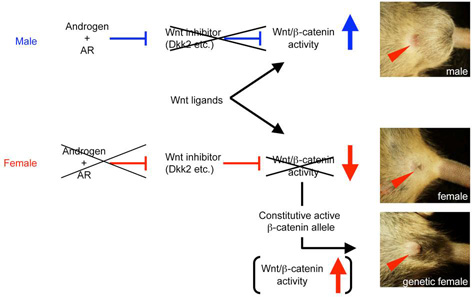
Shinichi Miyagawa, Yoshihiko Satoh, Ryuma Haraguchi, Kentaro Suzuki, Taisen Iguchi, Mark Makoto Taketo, Naomi Nakagata, Takahiro Matsumoto, Ken-ichi Takeyama, Shigeaki Kato and Gen Yamada. Genetic interactions of the androgen and Wnt/ β -catenin pathways for the masculinization of external genitalia. Molecular Endocrinology 23: 871–880, 2009
In most mammals, the sexually dimorphic development of embryos is typically achieved by the differentiation of the external genitalia. Hence, the sexual distinction of mammalian newborns is based on the external genital structure. Although it was shown in the 1940s and 1950s that androgen from the testes establishes the male sexual characteristics, the involvement of nongonadal and locally produced masculine effectors remains totally unknown. It is noteworthy that the disorders of fetal masculinization, including hypospadias, one of the most frequent birth defects, occur at a high frequency. Furthermore, their causative factors remain unclear. In this study, the involvement of the coordinated actions of androgen and the growth factor systems was genetically analyzed for the first time on mammalian reproductive organ formation. The results demonstrated that the Wnt/ β -catenin pathway is indispensable masculine factor for the external genital development. The bilateral mesenchymal region adjacent to the urethral plate epithelium displayed a sexually dimorphic activity of Wnt/ β -catenin signaling. Loss- and gain-of-function β -catenin mutants displayed altered sexualdevelopment of the external genitalia. These results indicate the novel functions of the Wnt/ β -catenin pathway as a locally expressed masculine effector. This could be the first genetic study analyzing the roles of the genetic interactions between androgen and locally expressed growth factor signaling during the development of reproductive organs. These results also shed new insight on the reproductive genetics and the causative factors of genital disorders.

Figure: Signal cascade for sexual dimorphism. Ectopic activation of Wnt/ β -catenin can induce “sex reversal” like external genitalia